Are all alkaline battery brands the same?
I’d often wondered whether there really were any differences among the major AA and AAA alkaline battery brands. Sure, Duracell and Energizer both put out numerous ads claiming to have the best battery life, but I figured that was nothing but boisterous marketing. Surely they must be about the same, right?
How wrong I was. You can indeed buy a bad brand-name battery. But I’m getting ahead of myself.
To answer the question, I decided to measure the actual usable capacity of AA and AAA alkaline batteries from the major brands under conditions simulating light to heavy loads. I wanted a rigorous, repeatable experimental setup, so I used an Itech 8511A+ programmable DC load on my lab bench to drain the batteries under precisely controlled constant-current conditions and recorded the data points on a PC. Each battery was in a properly sized battery holder, and it was connected to the load with a 4-wire setup.
Lest anybody claim I’m in the pocket of Big Battery, I bought all of the batteries I tested at retail, and I took no money from anybody.
I will admit that the testing scope kind of snowballed out of control and as a result took a lot longer than expected. I could test only one battery at a time, and when light loads met high capacities, it would take several days to complete a single test (of three) for each battery.
Fortunately, it turned out that a lot of batteries were crap, so some tests went unexpectedly quickly.
AA battery results
Energizer, Duracell, Amazon Basics, and Rayovac were the contenders in the alkaline AA ring, with two Duracell sub-brands represented (Copper Top and Quantum) and four Energizer manufacturing locations in the field (Poland, Indonesia, China, and the USA).
Round one? A light load, specifically 50 mA. While that level is still well above what you’d see in a very light load like a wall clock or a garden watering timer, it turns out that all of the batteries were pretty much the same there: 2700 mAh +/- 10%.
Why not test even lighter loads? Time constraints. The capacity in milliamp hours (mAh) is the number of hours of run time multiplied by the load in milliamps. That works the other way, too, so you can find how long a test took by taking the capacity in mAh and dividing by the current in mA, giving hours. A 2700 mAh battery at 50 mA already takes over two days (54 hours) to test; testing at 10 mA would take about a week and a half. I didn’t have that kind of time or patience, but somebody else did.
As the load was stepped up to 200 mA, which you might see with a flashlight on “low”, some differences among the brands emerged!
With a 200 mA load, there was more than a factor of two difference between the worst performer (the Energizer Max AA manufactured in Indonesia) and the best performer (a Duracell Quantum). The Coppertop Duracell sub-brand was near the top, as was the Rayovac, while the Amazon Basics options had middling performance not far ahead of the worst Energizers.
Oddly, the performance of the Energizer batteries was very strongly tied to the manufacturing location. The Energizer batteries made in China performed pretty well — right up there with the Duracells and Rayovac. However, the Energizer batteries made in Indonesia and Poland were terrible. The Energizers made in the USA were pretty good but not great, sitting somewhat back from their Chinese brethren.
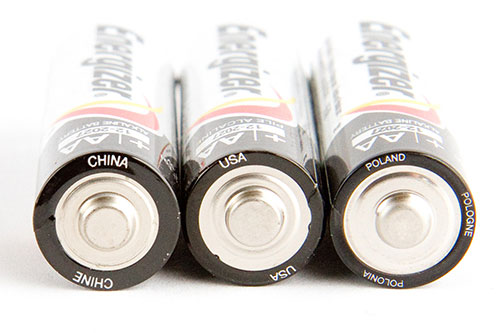
Not all Energizer AA alkaline batteries are made in the same place, and the quality can differ according to the manufacturing location. The place of origin can be found on the positive side of the battery.
The same trends held at the 500 mA level, similar to a reasonably bright LED flashlight. The Amazon cells and the Indonesian and Polish Energizer cells occupied the rear again, with only about half the capacity of the Duracells and Rayovac, which were again in the lead. The American and Chinese Energizers rounded out the front group, about 15% off of the best performer, the Duracell Quantum.
The take-aways from the AA tests:
- Duracell is a safe choice for AA alkalines
- There isn’t much of a difference between Duracell Quantum and Duracell Coppertop
- Avoid Amazon Basics AAs
- If you buy Energizer AAs, check the top of the cell (by the positive terminal) to make sure they weren’t made in Indonesia or Poland
Half-time assessment
The Energizer bunny sure has a good side and a bad side, at least based on the AA tests. Energizer fanboys aren’t going to be happy.
On the other hand, Duracell partisans are probably feeling pretty smug. The Copper Top (and Quantum) cells were consistently great in the AA tests.
Other than the Energizer results, the big surprise for me was how poorly the Amazon Basics cells fared. Since those are also made in Indonesia, and since certain tell-tales on them look very similar to the Indonesian Energizers (but not the other Energizers), I can’t help but wonder if perhaps both Amazon and Energizer sourced some AA batteries from the same OEM in Indonesia. Just speculation, nothing more.
On to the smaller batteries. Would the same relative brand results hold? Spoiler: no.
AAA batteries
I did a limited test of cheap alkaline AAA batteries last year, but this time around I looked at the brand name offerings. Alkaline AAAs from Duracell (Coppertop and Quantum), Energizer, Rayovac (Fusion and normal), and Amazon Basics were in the running. All of the Energizer AAAs I found were made in the USA, unlike with the AAs.
At the 50 mA level, which would provide data that would be useful for selecting the cells for your TV remote, even the worst performer was only 15% back from the best performer. Thus, for light-load applications, just get whichever of them is cheapest and don’t worry too much about it.
Things got more interesting at the higher drain currents, which would be relevant for things like LED headlamps, flashlights, or radios.
The best and worst options at 200 mA were both made by Rayovac: the normal alkaline Rayovac was the worst, but the Rayovac Fusion was the best. Close behind the Rayovac Fusion was the Amazon Basics AAA. Energizer and Duracell were mid-pack and about even with each other.
At the highest drain level, 500 mA, the Rayovac Fusion option blew away the competition, while the normal alkaline Rayovac was dead last. I mean, dead first. I mean… it had by far the lowest usable capacity, only about 50% of that of the Fusion sub-brand. The Amazon Basics option was pretty good, and the Duracell and Energizer entrants were both closer to last place than to the front-runner.
In other words, the AAA results were entirely different than the AA results. Just because a manufacturer can make a good AA battery doesn’t mean they can make a good AAA battery, and vice-versa. Or, in the case of Rayovac, they clearly know know to make a good AAA battery but choose not to apply that knowledge uniformly across their product lines.
The take-aways from the AAA test:
- Duracell and Energizer are about even in AAA land, but neither are particularly good
- Amazon has a decent AAA battery even though they’re bad at AA batteries
- Rayovac Fusion alkaline AAA batteries are really good at high loads, but the normal Rayovac alkaline AAAs are terrible
- For light loads, everybody is about equal. The only real differences are at higher loads
Conclusion
Duracell was consistently decent, though not always the best. Energizer was surprisingly inconsistent based on the manufacturing location used for a particular lot. Rayovac was great for AAs, great for some AAAs, and terrible for some AAAs. Amazon’s “Basics” house brand was roughly the opposite: great for AAAs but pretty bad for AAs.
Now I need to figure out what to do with all of these terrible Polish and Indonesian Energizer AAs…
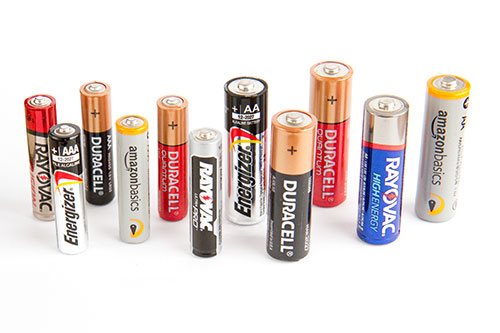
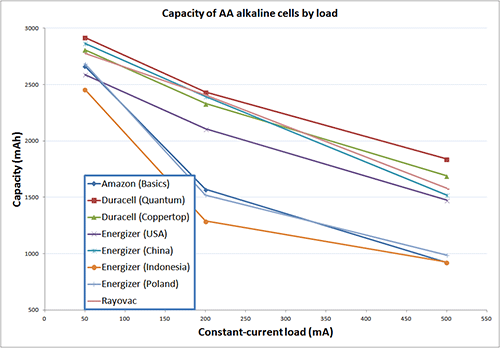
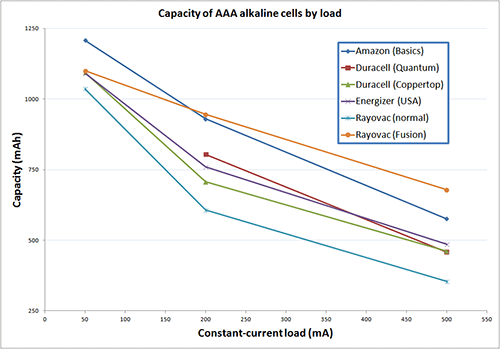
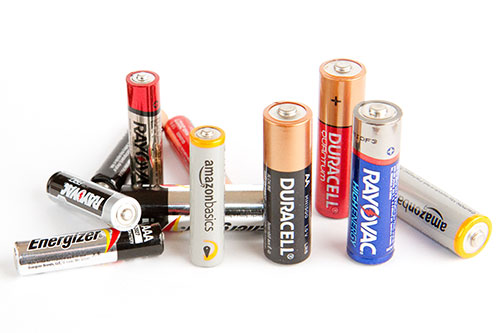
Any info on the lithium AA or AAA options compared to each other or compared to the alkaline options?
I know that in 9v batteries there is a difference in output characteristics between the alkaline vs lithium that makes the lithium unsuitable for some applications like some electronic locks.
@Ben
Sure. I also tested the Energizer lithium AA and AAA options, and they were dramatically superior to all alkaline batteries of their respective sizes. Regardless of the load, up to the maximum test current of 500 mA, the Energizer AA lithium showed a capacity of about 3300 mAh, and the Energizer AAA lithium showed a capacity of about 1250 mAh.
Not only was the capacity higher, but the voltage also stayed higher throughout the discharge curve. Whereas an alkaline AA has an average voltage of about 1.2 V under load (not to be confused with the 1.5 V nominal open-cell voltage), a lithium AA will maintain a voltage under load of about 1.4 V.
Moreover, the discharge curve of an alkaline AA will slope downward gradually, so you might see a voltage under load of about 1.4 V when the battery is new but only 1.0 V when the battery is nearly depleted. In contrast, the discharge curve of a lithium AA is very flat, so it will be about 1.4 V through its entire life before suddenly falling off a cliff at the very end.
Any device that can tolerate an alkaline AA should be able to run with a lithium AA. Where you’ll run into problems is if that device tries to estimate the remaining battery life. It will probably be expecting an alkaline discharge curve, so it won’t be able to ascertain where it is on the lithium discharge curve. As a result, if you put lithium AAs in a device that expects alkaline AAs, that device will probably show 100% battery life until the batteries are about 95% used up, at which point it will very rapidly show a decrease to zero. No actual harm, just a poor indication of how much battery life is remaining.
In short, if cost isn’t a factor, and you don’t mind the possibility of an inaccurate battery gauge, lithium AAs and AAAs are the way to go.